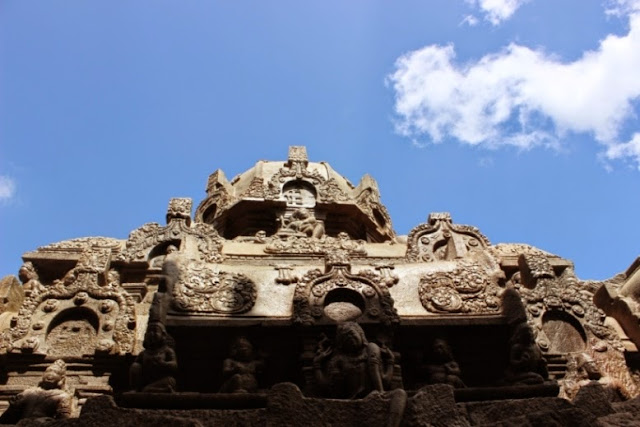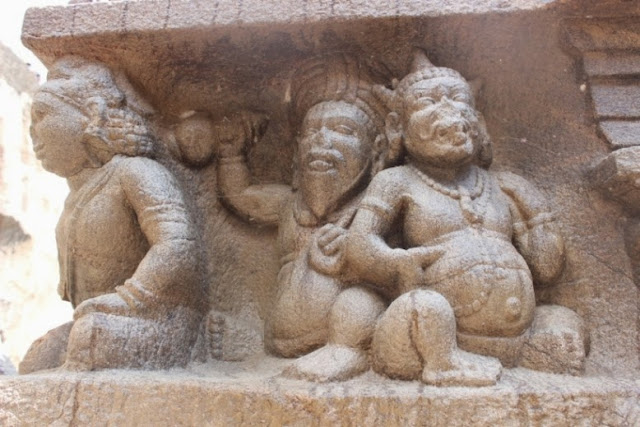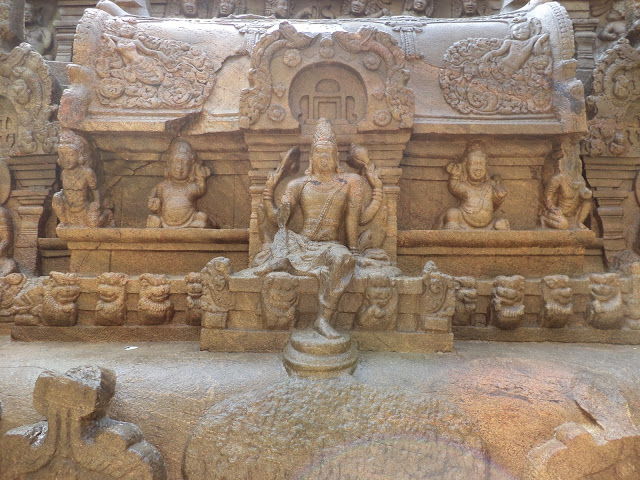Vettuvan Koil, Kalugumalai, Thoothukudi – Architecture
The
temple is located in Kalugumalai, a rocky hill in Thoothukudi district in southern Tamilnadu. The temple is carved out from a single rock in a
rectangular portion measuring 7.5 m (25 ft.) in depth. The carvings
in the temple show the top portion of the temple, with an unfinished bottom.
The sculptures and the carvings are indicative of Pandyan art during the
period. The granite rock looks like a blooming lotus, with hills surrounding it
on three sides. The vimana (ceiling over the
sanctum) has niches of Parsava devatas, the attendant deities of Shiva, like
ganas, Dakshinamurthy depicted playing
a mridanga, Siva with his consort Uma, dancers, various niches of Nandi (the sacred bull of Shiva) and animals like
monkeys and lions.
Historian
Sivaramamurti believes that this is the only place where Dakshinamurthy is
depicted playing the Mridanga (a percussion instrument), while in all other
places, he is depicted playing Veena. Epigrapher like V. Vedachalam believes that there is spontaneity
in the sculptures indicating of natural human movements like in the Shiva and
Uma sculpture where they seem to be talking like common folks. The other
portions of Kalugumalai houses the 8th century Jaina Abode and Kalugasalamoorthy Temple, an unfinished Shiva temple.
Historians
have equated the temple with similar temples across India based on the monolithic classification. Historian
K.V. Soundara Rajan believes that the temple is similar in architecture to that
of Virupaksha Temple at Karnataka by Vikramaditya
II during 734-44, Kanchi Kailasanathar Temple built by Narasimhavarman II during 685-705 AD and Kailasa temple, Ellora by Krishna
I during 756-77. Some historians believe that
the similarities in the architecture are indicative of the political relations
between the Pallavas, Rashtrakutas and Chalukyas, which is highly debatable.
This east facing
monolithic rock cut temple is the main attraction of Kalugumalai site and it
receives the significant place in monolithic rock cut architecture and often
draw comparison with monolithic Kailasanath temple in Ellora, monolithic
temples of Pallava at Mamallapuram such as Arjuna ratha, Dharmaraja ratha and
Pidari ratha and structural temples such as Shore temple and Mukunda
Nayanar temple in Mamallapuram, Vijayalaya Cholisvaram in Narthamalai and
Pattadakal in Bijapur, Karnataka.
These monuments may be considered as a precursor of Vettuvan koil. In the book Kalugumalai and Early Pandyan Rock-cut Shrines, C. Sivaramamurti remarks “By far the most beautiful rock-cut temple of the Pandya period is the one at Kalugumalai, a half-finished free-standing monolith which recalls the famous temple of Siva at Ellora.”
For the
first time full-fledged stone monolithic vimana with all its basic six parts,
the basement, wall, roof, griva, sikhara, and the stupi was attempted in Arjuna
ratha, Dharmaraja ratha in Mamallapuram. It was at Arjuna ratha, two-tiered
monolith, Karna kuta (square shrine placed on corners) and
Salas (oblong shrine placed on sides) as well as octagonal
shaped Shikara (head) and Griva (neck) have been
introduced. The Karnakutas and the Salas above the roof are together
called a 'Hara'.
In
Dharmaraja ratha a novel element called 'Panjara' was brought in between the
Karnakutas and the Salas in the Hara structure. The Pallava sculptors
treated the hara, shikharas and griva with skill and concern to represent
miscellanea. The Pallava sculptors also chiseled the sculptural
masterpieces on all the tiers of these monoliths including different themes
from Hindu Puranas representing Shiva, Somaskanda, Vishnu, Krishna, Varaha,
Brahma, Mahishasuramardhini and other deities.
The
architecture and sculptures in Vettuvankoil reverberate the style of early
Pandya era mandapa (hall) without any pillar and
sanctum (garbha-griha). Adhishtana (plinth or base), pada
(pillars - wall) and prastara (roof) have not taken shape. The Pandya sculptors
have only completed roof, two tiers, octagonal griva and octagonal shikara. The
adhishtana and pada portions are incomplete. The walls, floors and roof of the
mother rock including interiors and exteriors sanctum and mandapa appear rough
and unfinished.
At a
later date a Pillaiyar aka Vinayakar idol was installed and worshiped. The
incomplete rock cut monolith temple appears plain and simple look. The typical
kapota or cornice is roughly sculpted between the prastara and the first tier
of the vimana and it is common for all South Indian temple structures.
The horseshoe-shaped kudus are carved on kapota without any
refinement with a row of hara over it.
In
Vettuvankoil the aditala or the first tier has the regular arrangement of the
hara above the edge of the roof (harmya). Hara includes the string of miniature
shrines known as Karnakutas and salas. The shikhara of Karnakutas and
salas have nasika (kudu like structure) on all four sides. Kudus are carved on
these shrines with an image placed below the kudu. The image is large enough to
cover the niche formed by pilasters of this storey.
The Karnakutas
and sala are decorated with annavasal-karukku design and maiyappalaikarukku design
with a kodimangai (nymph) appears in reclining posture. The typical kapota or
cornice is sculpted with refinement in the first tier of the vimana. The kudu
('Nest') an arched or horse-shaped opening are carved on kapota. The
kudus are adorned with interesting feminine figure in the middle. Canonical
pilasters below the kudu encloses beautiful feminine figurine.
A frieze
of 'bhuta ganas' shown under the cornice in the first tier of the Vimana.
The dwarf attendants of Lord Siva, super human being, are shown with odd
characteristics - strange dwarf figures, some are seen with pot bellies, some
with swelled faces, some with projected teeth, some playing the flute, some
drumming, some dancing, some clapping etc. A frieze of Ganas is
often an Indian temple architectural motif and prescribed in the
canonical texts of Hindu temple architecture. Many odd images of the
bhuta ganas are shown in various actions mostly of dancing.
The
south sala shrine houses the image of Lord Shiva appear seated in Suhasana
posture with the left leg hanging down and the right leg placed on
the right thigh; the body is slightly slanting towards the left
and leaning forward. Of the four hands, the back right hand holds deer and
the back left hand holds mazhu (an axe-like weapon), the front left
hand resting on the left thigh and the front right hand is showing abhaya hasta mudra
(broken).
His hair is arranged in jatamakuta. The ear ring is Badra kundala. The yagnopavita (sacred cord) runs across his chest and the ornamentation includes kandikai, udara bandha, nagabandha armlets bands, bracelets and anklets.
The west
sala shrine houses the image of Vishnu, appear seated in Utkutikasana
posture with the left leg hanging below the seat and rests on a pedestal
while right leg kept bent upwards. He holds the chanka (conch) in his back left
hand and his back right hand holds the characteristic Prayoga Chakra (an early
sculptural feature where the Chakra is held straight instead of the later
side-on posture).
He rests his left hand on the seat and the right hand is broken. The body is slightly slanting towards left. Lord wears Krita makuta, kundala earring, yagnopavita (sacred cord) runs across his chest and ornamented with sarapali; udarabandha, keyyura / tolvalai and valai. He wears silk dhoti around the waist. The seat of the Lord is supported by two Simha images.
The
north sala shrine houses the image of Brahma appears seated
in Utkutikasana posture. Of the four hands, his back right hand holds
akshamala; the left hand holds lotus flower; the front right hand is resting on
his right thigh and the front left hand rests side wards on the floor. His hair
is arranged in jata-bandham. The yagnopavita (sacred cord) runs across his
chest and ornamented with sarapali, udara-bandha, armlets, bracelets and
draping the bright yellow garment on his waist.
The
square capstone is interspersed between the top of the second storey of the
vimana and the base of the octagonal griva. At the top of the square
capstone of the second storey four Nandi images are placed one each at four
corners at the square base of the griva. These Nandis either face east or
west but no north and south. The capstone cornices are embellished
with lion (yali) frieze.
Above
the second tier is placed the octagonal griva (neck) which is topped with octagonal
shikara. The octagonal shaft of the griva is decorated with pilasters
adorned with kodikarukku. The octagonal form of shikara put the vimana under
Dravida architectural style.
Octagonal shikara has maha-Nasikas embellished with a kind of sculptural ornamentation known as 'Koor karukku' in middle of each side. Kodipalai Karukku, a kind of sculptural ornamentation, adorns the corner joints of the octagonal bar. Below maha-Nasikas niches are provided and the niche houses the veritable gallery of sculptures.
Shiva as
Uma Samhita Murthy with consort Uma (Parvathy) appears below the east
mahanasika. The Lord is depicted in 'Ardha Padmasana' posture with four
hands. The rear right hand holds mazhu (an axe-like weapon) and
the left hand holds the maan (deer).
The right forehand shows some mudra (broken) and left forehand rested on the lap. His hair is arranged in jatamakuta. The ear ring is Badra kundala. Theyagnopavita (sacred cord) runs across his chest and the ornamentation includes kandikai, udara bandha, elbow bands, bracelets.
The
consort is depicted in 'Maharaja Lilasanam' posture seated with royal
ease with right leg bent to rest on the seat and the left leg bent
upwards. The goddess wears karanda makutam a head-gear. She also
ornamented with rich necklaces, keyyura or tolvalai, bracelets and fine
clothing and mekhala in the waist. The excellently modeled images of the
divine couple appear seated casually with ease. Graceful smile of Shiva
attracts the consort and she looks at him with slight tilt of head. The
sculpture exhibits the well-developed craftsmanship of the early Pandyas
and strikes the correct balance between dignified masculinity and graceful
femininity.
Shiva
as Pushkara Dakshinamurthy, the Master of instruments appears below the
south mahanasika. The Lord is depicted with four arms and his upper body
is slightly turned and slanting towards the right, balancing the mridanga held
gracefully upon his right thigh. With the two forehands the Lord is
playing on an mridanga (drum with two faces). The Lord appears
in virasana posture with left leg is stretched down (lambaka padam)
and is stamping upon (samharaka) the dwarf (apasmara – purusha: representing
ignorance and delusion).
This
suppression (nirodha) of ignorance is described as the tirobhava aspect of Sri
Dakshinamurti. And, his right foot bent at the knee is resting on his left knee
or thigh (Sayanam padakkam or kunchita-paada). His hair is arranged
as jatamandala woven into circular form. His sitting posture is
relaxed; his body position and carriage is free from bends and rigidity.
His general aspect is calm and meditative. Lord wears karnavali or vrutta-abharana or open circular earring, yagnopavita (sacred cord) runs across his chest and ornamented with sarapali; kati-bandha jeweled waist band; naga-bandha armlets and anklets. The sculpture is breathtakingly real and artistic.
Vishnu
as Lord Narasimha (lion-headed avatar of Vishnu), appear below the west
mahanasika and keep seated in yogasana or in meditation posture with the two
legs crossed each other like the Swastika symbol. He holds the chanka (conch)
in his back left hand and his back right hand holds the characteristic Prayoga
Chakra (an early sculptural feature where the Chakra is held straight instead
of the later side-on posture).
He rests
his left hand on the seat and the right hand is broken. The body is slightly
slanting towards left. Lord wears Krita makuta, kundala earring,
yagnopavita (sacred cord) runs across his chest and ornamented with
sarapali; udarabandha, keyyura / tolvalai and valai. He wears dhoti
around the waist. The seat of the Lord is supported by two Simha images.
Brahma appears
below the north mahanasika and keeps seated in Ardha Padmasana (cross-legged
- in the Half-Lotus posture) posture on a lotus seat. Of the four
hands, his back right hand holds akshamala (rosary beads); the left hand holds
lotus flower; the front right hand is in abhaya mudra and the front left hand
rests on his thighs.
His hair is arranged in jata-bandham. The yagnopavita (sacred cord) runs across his chest and ornamented with sarapali, udara-bandha, armlets, bracelets and draping the bright yellow garment on his waist. Two elephants are shown before the lotus pedestal.
The shikara
top shows a small pit by which we can easily guess about the presence of finial
or stupa and now it is absent. The octagonal shikara is decorated with a lotus
whorl on top. The lavish decoration of the shikara with Kodipalai karukku and
the Mahanasikas with Koor karukku.



















































































































































